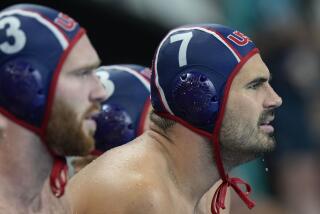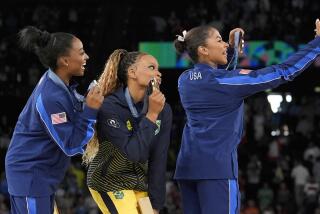Carver Is Focal Point for USOC
- Share via
John Carver, an expert on the ways boards of directors work, has emerged as perhaps the pivotal figure in the remaking of the U.S. Olympic Committee.
Earlier this month, an internal USOC reform panel issued recommendations based on Carver’s work and his notions of clearly defined responsibilities and accountability -- even though he was virtually unknown within much of the USOC as recently as February. That blueprint, a number of insiders said, has become the working reference point for USOC reform.
The blueprint said the USOC needed a clear mission, then defined it as winning Olympic medals. It said the USOC board of directors ought to be trimmed from 123 to nine. It also said the new board ought to identify core values and set broad policy but delegate day-to-day affairs to a chief executive.
On April 25 in New York, a committee appointed by the U.S. Senate convened a town hall-style hearing into the USOC’s structure and culture -- the issues at the root of political infighting that erupted earlier this year into one of the worst management crises in USOC history. The president, CEO and several other USOC officials resigned; Congress held three hearings in a matter of weeks.
The Senate panel, due to issue its recommendations by June 30, is under no obligation to follow the USOC blueprint. But a source familiar with the Senate panel said it was “very interested in the hard and direct way the [USOC] task force put together its plan.”
The USOC plan, as even its authors acknowledge, is far from complete. Looming, for instance, are potential conflicts with International Olympic Committee rules. Brewing are uncertainties about whether Carver’s ideas can be applied to “independent” directors summoned to help shepherd the USOC -- because it can take years to learn the workings of the Olympic movement.
Even so, the blueprint has emerged as the starting point for change.
Frank Marshall of Los Angeles, one of the co-chairs of the internal reform panel, said Carver provided “the foundation for our recommendations.”
Carver, 64, based in Atlanta, author or coauthor of five books and more than 170 articles on the workings of corporate or not-for-profit boards, called the USOC in early February, offering to help after reading news reports about its management implosion.
The USOC is essentially divided into two rival camps, volunteers and staff, a fracture that for years has invited power struggle. The volunteers make up a 123-member board, which usually meets twice a year, and an executive committee, typically 23, which meets every few weeks and in which most power resided. The paid staff, headed by a CEO, numbers about 500.
Congress put the USOC in charge of the Olympic enterprise in 1978 through what is called the Amateur Sports Act. That law may now be rewritten. It’s not that he was lacking for work, Carver said when he called offering his help. As a consultant to school boards, governments, businesses and charities across North America, “I’ve got more business than I know what to do with,” he said.
Nor, he said, was he looking to get rich. He asked only for expenses -- perhaps $5,000, Marshall estimated. What motivated Carver, he said, was that the USOC is “just a damned important organization in the social scheme of things in this country.” Carver’s idea is that too often too many boards are either micromanaging or rubber-stamping -- producing politics, not policies.
A board’s job, according to Carver, is to set values and broad policy strokes -- what he calls “the ends.” It’s the CEO’s job to figure out the means to get there. “The job has to be designed logically and done such that everybody in the whole chain is accountable,” he said.
Marshall said, “[Carver] said to us he was not interested unless we were serious.” They were, the USOC representatives said. “We started with a clean piece of paper and no rules,” Marshall said.
First onto the paper was the mission. “When you focus down on what everyone in Washington was talking about,” at the congressional hearings, “it’s about Olympians, it’s about the Olympics,” Marshall said. “We felt the pipeline we were constructing has to end in the [medals] podium.”
The board of directors had to be cut, and Carver’s theories would call for the elimination of the executive committee -- precisely what the task force recommended.
But what size ought the new board be?
The smaller the better, according to Carver.
At nine, it would include four “independent” members -- meaning at least two years past any ties to the Olympic movement -- as well as two from sports federations, two from athletes’ groups and one U.S. member of the IOC. Currently, all three U.S. IOC members serve on the USOC executive committee.
The blueprint was unveiled two weekends ago at a USOC meeting in Fort Worth.
Sports such as bowling and water skiing, which are featured at the Pan American Games but not the Olympics, have since said they want to be included in the mission statement.
“If we don’t, it will be a slow death,” said Tony Baggiano of the U.S. water skiing federation.
Others have registered concern that a nine-member board would violate rules requiring all IOC members to be included on their nation’s Olympic board of directors. The IOC also requires that representatives from sports federations must make up the “voting majority” on the national board -- which the blueprint would seem to violate absent a weighted voting system.
Thomas Bach of Germany, an IOC vice president who also heads its “juridical commission,” which deals with such issues, signaled reassurance. He said, “I think you can achieve everything the USOC intends to achieve within the framework of the [IOC] charter.”
Perhaps more problematic, were the Senate panel to take up the blueprint and the Carver principles to be ratified, would be their implementation.
Carver has said that his principles ought to be adopted wholesale. But as one longtime USOC insider put it, “Given the USOC’s proclivities to muck around with things, 50% might be the max, and then what?”
In Orlando, Fla., the Orange County school board formally took up the Carver principles in 1997. Susan Arkin, a school board member since 1992, said, “If doing this makes you 75% or 80% more effective than not -- it’s not perfect, but why wouldn’t that be better than where you started?”
More to Read
Go beyond the scoreboard
Get the latest on L.A.'s teams in the daily Sports Report newsletter.
You may occasionally receive promotional content from the Los Angeles Times.







